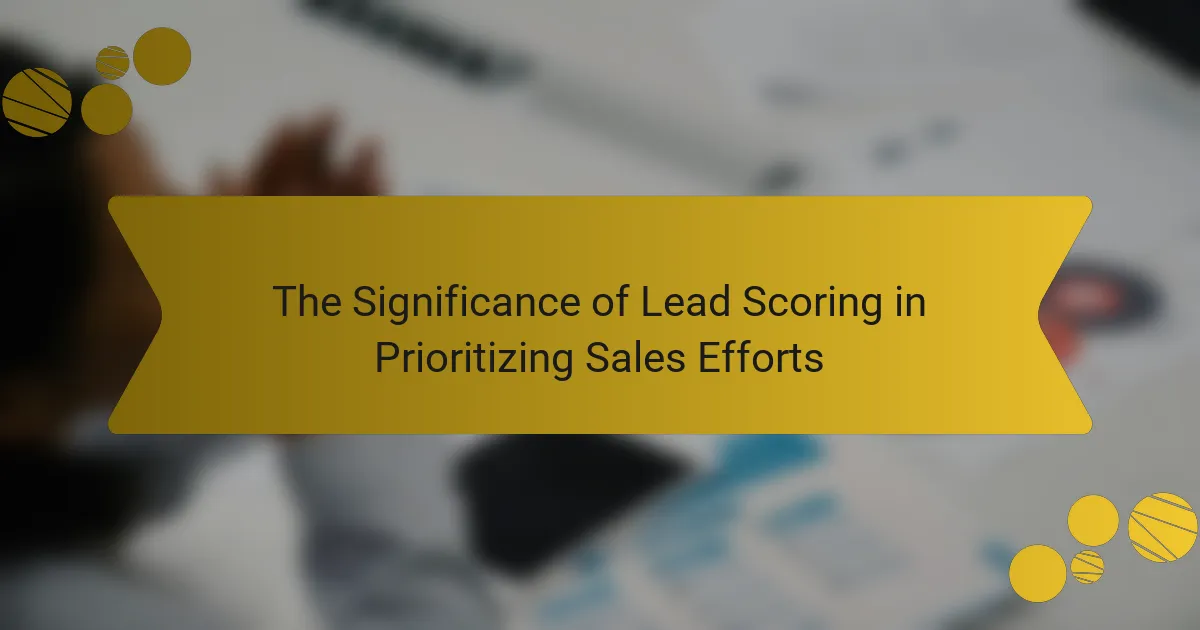Lead scoring is a systematic process that ranks prospects based on their readiness to purchase, allowing sales teams to prioritize leads most likely to convert. This process evaluates various factors, including demographic information and engagement levels, to optimize resource allocation. Companies that implement lead scoring can see significant improvements in lead generation ROI and sales efficiency. Effective lead scoring involves establishing clear criteria for evaluating leads, assigning numerical values to key attributes, and utilizing CRM systems for automation. Regularly reviewing and adjusting the scoring model ensures alignment with market changes, while training sales teams on interpreting lead scores enhances prioritization and conversion rates. Best practices include integrating multiple data sources and leveraging automation tools for accuracy.

What is Lead Scoring and Why is it Important in Sales?
Lead scoring is a systematic process used to rank prospects based on their readiness to purchase. This ranking helps sales teams prioritize their efforts on leads most likely to convert. Lead scoring considers various factors, including demographic information and engagement levels. By analyzing these attributes, businesses can effectively allocate resources. Research indicates that companies using lead scoring see a 77% increase in lead generation ROI. This method enhances sales efficiency and improves conversion rates. Prioritizing high-scoring leads allows teams to focus on prospects that are more aligned with their offerings.
How does Lead Scoring work in prioritizing sales efforts?
Lead scoring prioritizes sales efforts by assigning numerical values to leads based on their engagement and fit. This process helps sales teams identify which leads are more likely to convert into customers. Factors such as demographic information, online behavior, and interaction history contribute to the scoring. Higher scores indicate a greater likelihood of conversion. For example, a lead that downloads a whitepaper and attends a webinar may receive a higher score. This allows sales teams to focus on leads that show strong interest and potential. Consequently, resources are allocated more efficiently, increasing the chances of closing deals.
What are the key components of a Lead Scoring system?
The key components of a Lead Scoring system are criteria, scoring model, and data integration. Criteria define the attributes that determine lead quality. These may include demographic information, engagement level, and buying signals. The scoring model assigns numerical values to these criteria based on their importance. This helps prioritize leads effectively. Data integration ensures that the system pulls information from various sources, such as CRM and marketing automation tools. This integration provides a comprehensive view of each lead. Together, these components create a structured approach to evaluating and prioritizing leads for sales efforts.
How do businesses determine the scoring criteria for leads?
Businesses determine the scoring criteria for leads by analyzing various attributes that indicate a lead’s potential value. These attributes often include demographic information, engagement level, and purchasing intent. Companies typically use historical data to identify which characteristics correlate with successful conversions. They may also develop scoring models based on buyer personas and sales team feedback. Additionally, lead scoring can incorporate data from marketing automation tools to assess interactions, such as website visits and email opens. This data-driven approach helps prioritize leads that are more likely to convert into customers. Research shows that organizations using lead scoring can improve sales efficiency by focusing on high-quality leads.
What benefits does Lead Scoring provide to sales teams?
Lead scoring provides numerous benefits to sales teams. It enables prioritization of high-quality leads, increasing conversion rates. Sales teams can focus their efforts on leads that show the most potential. This targeted approach saves time and resources. Additionally, lead scoring improves collaboration between marketing and sales teams. It aligns both teams on what constitutes a qualified lead. Research indicates that companies using lead scoring see a 20% increase in sales opportunities. This statistic underscores the effectiveness of lead scoring in enhancing sales performance.
How does Lead Scoring improve conversion rates?
Lead scoring improves conversion rates by identifying and prioritizing high-quality leads. This process allows sales teams to focus their efforts on prospects most likely to convert. By analyzing behaviors and attributes, businesses can assign scores to leads. Higher scores indicate stronger potential for conversion. Research shows that leads who receive follow-ups based on scoring are 30% more likely to convert. This targeted approach enhances efficiency and increases overall sales success.
What impact does Lead Scoring have on sales efficiency?
Lead scoring significantly enhances sales efficiency by allowing sales teams to prioritize high-quality leads. This prioritization enables sales representatives to focus their efforts on prospects more likely to convert. Research indicates that organizations using lead scoring can increase their sales productivity by up to 30%. By identifying and nurturing leads based on their behavior and engagement, teams can tailor their approach. This targeted strategy minimizes time spent on unqualified leads. Additionally, lead scoring helps in aligning marketing and sales efforts, creating a more streamlined process. Consequently, companies experience improved conversion rates and higher revenue generation.

How can businesses implement Lead Scoring effectively?
Businesses can implement lead scoring effectively by establishing clear criteria for evaluating leads. This involves defining key attributes that indicate a lead’s potential value. Common attributes include demographic information, engagement level, and purchase intent.
Next, businesses should assign numerical values to these attributes based on their importance. For instance, a lead from a target industry may receive a higher score than one from a non-target industry.
Utilizing a CRM system can streamline the lead scoring process. These systems can automate score calculations based on the predefined criteria.
Regularly reviewing and adjusting the scoring model is crucial. This ensures alignment with changing market conditions and business goals.
Finally, training sales teams on how to interpret lead scores enhances the effectiveness of the strategy. This approach leads to better prioritization of sales efforts, maximizing conversion rates.
What steps are involved in setting up a Lead Scoring model?
Identify your target audience. Understanding who your ideal customers are is essential. Analyze existing customer data to find common traits.
Define scoring criteria. Establish the attributes that will be used to evaluate leads. These can include demographic information, engagement levels, and purchase intent.
Assign point values to each criterion. Determine how much weight each attribute will carry in the scoring process. Higher values should reflect attributes that indicate a stronger likelihood to convert.
Collect data on leads. Gather information through forms, surveys, and behavioral tracking. Ensure that data is relevant to the scoring criteria established.
Implement a scoring system. Use software or tools that can automate the scoring process. This will streamline the evaluation of leads based on the defined criteria.
Test and refine the model. Monitor the effectiveness of the lead scoring system. Adjust point values and criteria as necessary based on conversion rates and feedback.
Train your sales team. Ensure that the sales team understands how to interpret lead scores. Provide guidelines on how to prioritize leads based on their scores.
Review and update regularly. Periodically reassess the scoring model. This ensures it remains aligned with changing market conditions and business objectives.
How can data analytics enhance Lead Scoring accuracy?
Data analytics can enhance lead scoring accuracy by providing insights into customer behavior and preferences. It analyzes historical data to identify patterns that predict lead conversion. By utilizing machine learning algorithms, businesses can score leads based on various attributes such as engagement level and demographic information. This approach allows for real-time adjustments to scoring models as new data becomes available. According to a study by HubSpot, companies using data-driven lead scoring see a 20% increase in sales productivity. Accurate lead scoring helps prioritize efforts on high-potential leads, ultimately increasing conversion rates.
What tools are available for implementing Lead Scoring?
Tools available for implementing lead scoring include CRM platforms, marketing automation software, and specialized lead scoring tools. CRM platforms like Salesforce and HubSpot offer built-in lead scoring features. Marketing automation software such as Marketo and Pardot also provide robust lead scoring capabilities. Additionally, tools like Leadspace and Infer focus specifically on lead scoring and predictive analytics. These tools analyze various data points to assign scores to leads based on their likelihood to convert. This scoring helps sales teams prioritize their efforts effectively.
What common challenges do businesses face with Lead Scoring?
Businesses face several common challenges with lead scoring. One challenge is accurately defining scoring criteria. Many companies struggle to determine which attributes predict conversion effectively. This can lead to inconsistent scoring and misalignment with sales goals. Another challenge is data quality. Poor data can skew lead scores and result in wasted sales efforts. Additionally, businesses often face difficulties in integrating lead scoring with existing systems. This can create silos and hinder collaboration between marketing and sales teams. Lastly, frequent changes in customer behavior can make lead scoring models obsolete. Regular updates are necessary to maintain effectiveness and relevance.
How can organizations overcome inaccuracies in Lead Scoring?
Organizations can overcome inaccuracies in lead scoring by implementing data enrichment strategies. Data enrichment involves enhancing lead information with additional data points. This can include demographic, firmographic, and behavioral data. Accurate data helps improve scoring algorithms and enhances predictive accuracy. Regularly updating lead data is also crucial. Organizations should establish a routine to cleanse and verify lead information. Machine learning models can analyze historical data for better scoring. This approach uses patterns to refine lead scoring continuously. Additionally, feedback loops from sales teams can provide insights to adjust scoring criteria effectively. These methods collectively improve the reliability of lead scoring systems.
What strategies can be used to maintain Lead Scoring effectiveness over time?
Regularly reviewing and updating lead scoring criteria is essential for maintaining effectiveness. As market conditions and customer behaviors change, lead scoring models must be adjusted accordingly. Analyzing historical data helps identify which attributes correlate with successful conversions. Incorporating feedback from sales teams ensures alignment between scoring and actual sales outcomes. Implementing automation tools can streamline the scoring process and reduce manual errors. Additionally, segmenting leads based on behavior and engagement levels allows for more accurate scoring. Continuous training for the sales team on lead scoring updates fosters better utilization of the scoring system. Regularly testing and validating the lead scoring model against conversion rates ensures its relevance and accuracy.

What are the best practices for optimizing Lead Scoring?
The best practices for optimizing lead scoring involve defining clear criteria for scoring, regularly updating the scoring model, and integrating data sources. Establish specific attributes that indicate a lead’s potential value, such as demographic information and engagement level. Use historical data to inform scoring weights and adjust them based on performance metrics. Regularly review and refine the scoring model to reflect changes in market conditions and customer behavior. Incorporate data from multiple sources, including CRM systems and marketing automation tools, to create a comprehensive view of leads. Collaborate with sales teams to ensure alignment on what constitutes a qualified lead. Lastly, leverage automation tools to streamline the lead scoring process and enhance accuracy.
How can businesses continuously refine their Lead Scoring criteria?
Businesses can continuously refine their Lead Scoring criteria by regularly analyzing performance data. They should track conversion rates of leads to sales. This analysis helps identify which lead attributes correlate with successful conversions. Businesses can adjust their scoring models based on these insights. Regular feedback from sales teams can also inform necessary changes. Incorporating new data sources enhances the accuracy of lead scoring. A/B testing different scoring models can reveal the most effective criteria over time. Continuous monitoring and adjustment ensure lead scoring remains aligned with business goals.
What role does feedback play in improving Lead Scoring?
Feedback is essential for improving lead scoring. It helps refine the criteria used to evaluate leads. Regular feedback from sales teams identifies which leads convert effectively. This data allows for adjustments in scoring algorithms. Enhanced accuracy in lead scoring increases sales efficiency. Studies show that companies using feedback loops see a 20% increase in conversion rates. Feedback also fosters alignment between marketing and sales teams. This collaboration ensures that lead scoring reflects real-world performance. Overall, feedback is a critical component in optimizing lead scoring strategies.
How often should Lead Scoring models be reviewed and updated?
Lead scoring models should be reviewed and updated at least quarterly. Regular reviews ensure that the models reflect changes in customer behavior and market conditions. Additionally, significant events such as product launches or shifts in target demographics may necessitate immediate updates. Research shows that dynamic lead scoring can improve conversion rates by up to 30%. This adaptability allows sales teams to prioritize leads more effectively, directly impacting sales success.
What practical tips can enhance Lead Scoring outcomes?
To enhance lead scoring outcomes, implement data-driven criteria. Use demographic information to assess lead quality. Analyze engagement metrics such as email opens and website visits. Incorporate behavioral data to understand lead intent. Regularly update scoring models based on sales feedback. Align lead scoring with sales team insights for relevance. Test and refine scoring criteria continuously for accuracy. Research shows that companies using data-driven lead scoring see a 30% increase in conversion rates.
How can sales teams align their efforts with Lead Scoring results?
Sales teams can align their efforts with Lead Scoring results by prioritizing leads based on their scores. This means focusing on high-scoring leads that indicate a higher likelihood of conversion. Sales teams should analyze the attributes that contribute to lead scores. Understanding these attributes helps tailor communication strategies. Regularly reviewing and updating lead scoring criteria ensures relevance. Training sales representatives on interpreting lead scores enhances effectiveness. Utilizing CRM tools can automate the alignment process. Studies show that companies using lead scoring see a 30% increase in sales productivity.
What metrics should be tracked to measure Lead Scoring success?
Key metrics to track for measuring Lead Scoring success include conversion rates, engagement levels, and lead velocity. Conversion rates indicate the percentage of leads that become customers. Engagement levels assess how frequently leads interact with marketing content. Lead velocity measures the speed at which leads move through the sales funnel. Tracking these metrics provides insights into the effectiveness of lead scoring strategies. High conversion rates suggest accurate scoring, while low engagement may indicate the need for strategy adjustments. Lead velocity helps identify bottlenecks in the sales process. Collectively, these metrics enable organizations to refine their lead scoring systems for better sales outcomes.
Lead scoring is a systematic process that ranks prospects based on their readiness to purchase, enabling sales teams to prioritize efforts on leads most likely to convert. This article explores the mechanics of lead scoring, including its key components, criteria determination, and the benefits it provides to sales teams, such as increased conversion rates and improved efficiency. Additionally, it addresses common challenges businesses face with lead scoring and offers best practices for implementation and continuous refinement to enhance outcomes. The discussion emphasizes the importance of data analytics and feedback in maintaining effective lead scoring models, ultimately driving sales success.
